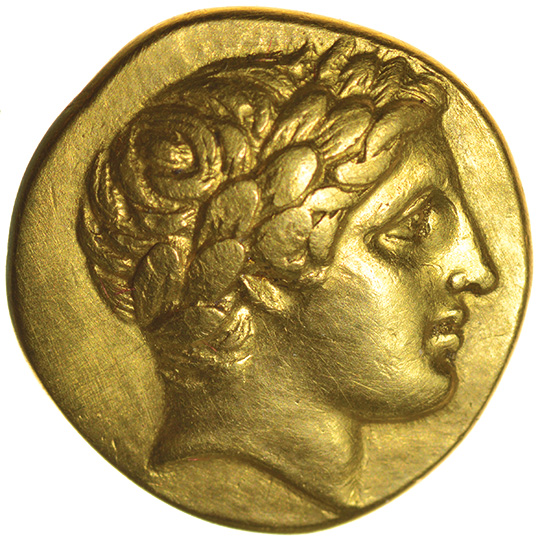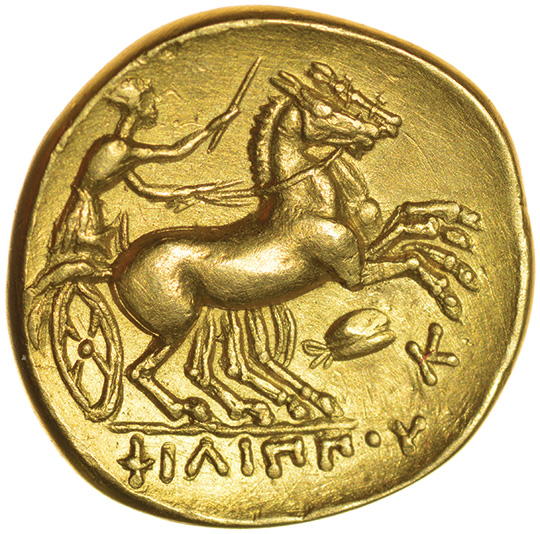1
Philip II of Macedon. Amphipolis. 359-336 BC. Celtic gold stater. 18mm. 8.44g.
Philip II of Macedon. Amphipolis. 359-336 BC. Gold stater. 18mm. 8.44g. Wreathed head of young Apollo-right./ Two-horse chariot right, charioteer with goad, Macedonian hat and letter K below, Philip's name in Greek in exergue. ABC fig. 5.1, p.3 and 10, VA p.4, S p.1, Evans p.24, Mack pl. IA, de Jersey (1996) fig.1, p.6, Le Rider pl.81, nos. 243a and 243b = obv. 101, rev. 191. Almost EF, magnificent specimen of historic prototype of so many Celtic staters, both Gaulish and British. Ex William F Stevens collection, Chris Rudd List 58, no.1,ex James Murphy.
When Philip became king in 359 BC he was only 23 and Macedon was a weak state on the fringe of northern Greece. In fact, Macedonians weren’t seen to be real Greeks. By the time he was assassinated at the age of 46 Philip had reorganised his kingdom, revolutionised the coinage, unified the squabbling states of European Greece, and planned to invade the Persian empire, with an advance army of 10,000 soldiers already across the Hellespont. The design on both sides of Philip II’s famous gold staters was politically inspired. The Greeks revered Apollo as one of their greatest gods. So, by featuring Apollo on the obverse, Philip positioned himself and his fellow Macedonians as true Greeks. The two-horse racing chariot reminded people that Philip himself had been a champion charioteer in the Olympic games and that he was now the ‘winner’ of all Greece. Much of the gold coinage of Gaul and Celtic Britain was derived from the gold staters of Philip II or posthumous versions of them. These staters reached France mainly via Switzerland, probably in the hands of returning Celtic mercenaries. This specimen, with its hamburger-like mintmark, was struck posthumously, c.323-315 BC, at Amphipolis, an Athenian colony near the rich silver-mining area of Mt. Pangaion in eastern Macedon, captured by Philip II in 356 BC. Illustrated by William Stevens in Coin News, June 2002, p.25 (this coin) and September 2003, p.22 (this coin) and published by Chris Rudd in Coin News, July 2019 (this coin).
Philip II of Macedon. Amphipolis. 359-336 BC. Gold stater. 18mm. 8.44g. Wreathed head of young Apollo-right./ Two-horse chariot right, charioteer with goad, Macedonian hat and letter K below, Philip's name in Greek in exergue. ABC fig. 5.1, p.3 and 10, VA p.4, S p.1, Evans p.24, Mack pl. IA, de Jersey (1996) fig.1, p.6, Le Rider pl.81, nos. 243a and 243b = obv. 101, rev. 191. Almost EF, magnificent specimen of historic prototype of so many Celtic staters, both Gaulish and British. Ex William F Stevens collection, Chris Rudd List 58, no.1,ex James Murphy.
When Philip became king in 359 BC he was only 23 and Macedon was a weak state on the fringe of northern Greece. In fact, Macedonians weren’t seen to be real Greeks. By the time he was assassinated at the age of 46 Philip had reorganised his kingdom, revolutionised the coinage, unified the squabbling states of European Greece, and planned to invade the Persian empire, with an advance army of 10,000 soldiers already across the Hellespont. The design on both sides of Philip II’s famous gold staters was politically inspired. The Greeks revered Apollo as one of their greatest gods. So, by featuring Apollo on the obverse, Philip positioned himself and his fellow Macedonians as true Greeks. The two-horse racing chariot reminded people that Philip himself had been a champion charioteer in the Olympic games and that he was now the ‘winner’ of all Greece. Much of the gold coinage of Gaul and Celtic Britain was derived from the gold staters of Philip II or posthumous versions of them. These staters reached France mainly via Switzerland, probably in the hands of returning Celtic mercenaries. This specimen, with its hamburger-like mintmark, was struck posthumously, c.323-315 BC, at Amphipolis, an Athenian colony near the rich silver-mining area of Mt. Pangaion in eastern Macedon, captured by Philip II in 356 BC. Illustrated by William Stevens in Coin News, June 2002, p.25 (this coin) and September 2003, p.22 (this coin) and published by Chris Rudd in Coin News, July 2019 (this coin).
Chris Rudd List 165
Ends from
Venue Address
General delivery information available from the auctioneer
Postage & packing will be added to all invoices. Unless specified otherwise all UK orders sent by Special Delivery. Orders up to £1000 cost £15, over £1000 cost £20. European orders sent International Signed For delivery £15, USA/Canada £25, Rest of World £20.
Important Information
Please read our terms and conditions before bidding.
Terms & Conditions
Terms & Conditions for Chris Rudd Auctions
These terms are summarised. Liz will be happy to answer any questions you may have. Please email liz@celticcoins.com or phone 01263 735 007 or 07990 840 816.
Our estimated value of each lot is given in the catalogue and online. Bidding starts at 80% of this estimate. Estimates shown in BLACK, Starting Prices shown in RED.
How to bid via Internet.Our Auction is conducted online via www.the-saleroom.com If you wish to bid you must ‘Create an account’ and you will receive an email link confirmation of Registration. This must be activated prior to bidding. You must register to bid for each auction. If you are a new bidder in our sale, please provide numismatic credit references and credit/debit card details to secure any bids you may place. Client data is confidential; we do not share our mailing list or client information unless authorised. We reserve the right to revoke any bids and registrations, restrict accesses, and modify or disable the site or any of its features, at our discretion. We do not make any guarantees regarding accessibility, accuracy, or security of this website with regard to registration of bidding. All financial transactions will be carried out by ourselves, the-saleroom.com requests card information for security reasons and will not debit your card.
How to bid by phone, fax or email. In addition to internet bidding, you may bid by mailing the bid sheet included with each catalogue, or by email, fax or telephone. If you choose to telephone your bids, we appreciate a written follow-up. Bids must be received by 12 midday (UK time) Friday 12 July, after this time we cannot guarantee that bids will be placed. If you wish for any guidance regarding current bids please contact Liz. Online bidding continues until the lot closes at 5pm (UK time) Sunday 14 July.
Bidding increments. Lots will be sold to the highest bidder for the winning bid. Bidding automatically increases in fixed increments, so you can enter your maximum bid and let our system do the bidding for you. Please ensure your bids comply with the steps outlined below:
Up to £500 in £20 increments
£500-£1000 in £50 increments
£1000-£2000 in £100 increments
£2000-£5000 in £200 increments
Over £5000 in £500 increments
If you enter a high maximum bid you will win at the current bid amount plus increment. Whole number bids only. Bidders personally guarantee that they will pay for their winning bids.
The first lot will close electronically at 5pm (UK time) on the sale date, with subsequent lots closing every 30 seconds thereafter. Please note: Sniper bids are not allowed. If you bid within the last 10 minutes the lot closing the time will extend by 10 minutes on that lot, from the time of bid.
Personal viewing of lots by appointment only. Please contact Liz to arrange.
How to pay. A 20% buyers fee (24% inc. VAT if applicable at the current rate), will be added to the hammer price of all successful online, written, fax, email and phone bids. Bids are placed in GB£ Sterling. Payment is preferred by direct transfer in £ Sterling (GB£): Chris Rudd Ltd Account Number: 63406857, Sort Code: 20-03-26 or by cheque, postal orders, cash (GB£). Or by International bank transfer to Barclays Bank PLC, Market Place, Aylsham, Norfolk NR11 6EW. IBAN: GB14 BARC 2003 2663 4068 57. SWIFTBIC: BARCGB22. Please ensure all charges are paid or add £6 to cover EU charges, £12 International charges. Visa, MasterCard or debit card accepted. We also accept US$ cheques with $25 bank fee added. Goods remain our property until paid in full. VAT no. GB 665532227.
Winning lots will be sent as soon as possible after receipt of payment on seven days approval. If you aren’t happy with a coin, please phone before returning it. Prices realised are available by subscription via the-saleroom.com
Postage & packing will be added to all invoices. Unless specified otherwise all UK orders under £50 sent first class £1, orders between £51-£99 sent Signed For Delivery £3, orders over £100 sent by Special Delivery £10. All overseas orders under £100 sent uninsured (at your risk) £6. European orders over £100 sent International Signed For delivery £15, Rest of World £20.
Privacy Your details are securely held and will not be shared. They will be retained for processing orders and marketing. Please let us know if you don’t wish to be contacted. You can do this at any time.
Export licences are needed for some coins and can take 4-6 weeks to get. Their purpose is to curb the export of national treasures.






